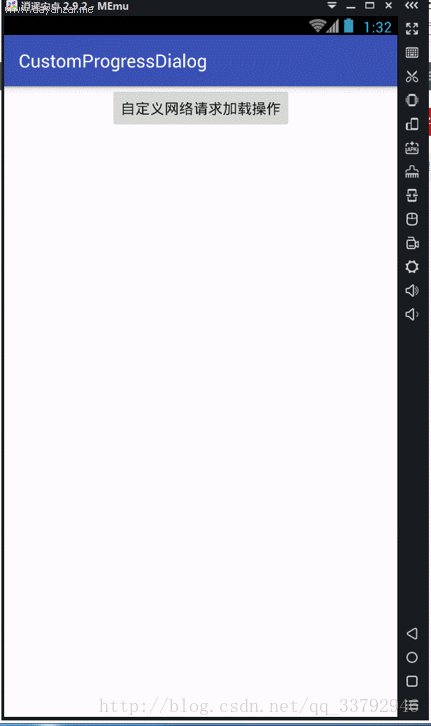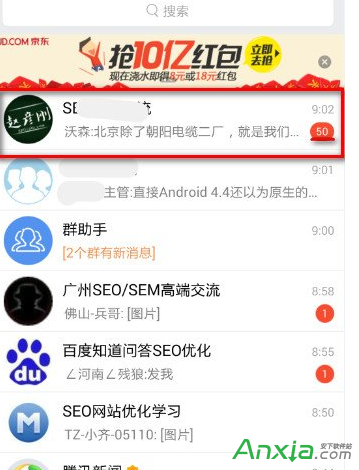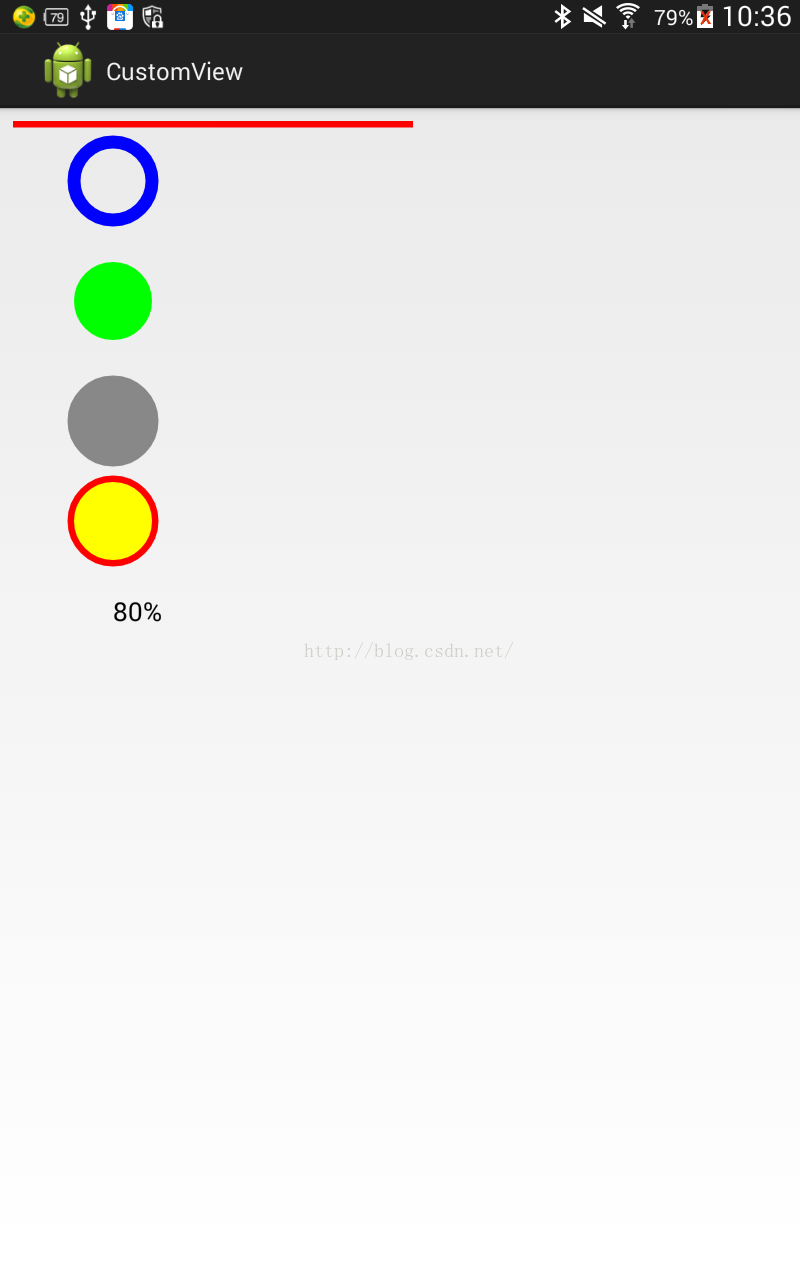編輯:關於Android編程
效果預覽

簡要說明
現在android程序網絡請求操作是必不可少的,然而擁有好的交互體驗的程序對網絡耗時操作的處理尤為重要。
代碼說明:
dialog_loading.xml
<?xml version="1.0" encoding="utf-8"?> <LinearLayout xmlns:android="http://schemas.android.com/apk/res/android" android:id="@+id/dialog_view" android:orientation="vertical" android:layout_width="fill_parent" android:layout_height="fill_parent" android:gravity="center"> <ImageView android:id="@+id/img" android:layout_width="wrap_content" android:layout_height="wrap_content" android:background="@android:color/transparent" android:src="@drawable/progress" /> <TextView android:id="@+id/tipTextView" android:layout_width="wrap_content" android:layout_height="wrap_content" android:layout_marginLeft="10dp" android:text="數據加載中……" /> </LinearLayout>
這個布局就是我們自定義的顯示布局,比較簡單明了,最外層一個垂直排列的線性布局,裡面依次是一個imageview和textview。
loading_animation.xml
<?xml version="1.0" encoding="utf-8"?> <set android:shareInterpolator="false" xmlns:android="http://schemas.android.com/apk/res/android"> <rotate android:interpolator="@android:anim/linear_interpolator" android:pivotX="50%" android:pivotY="50%" android:fromDegrees="0" android:toDegrees="+360" android:duration="1500" android:startOffset="-1" android:repeatMode="restart" android:repeatCount="-1"/> </set>
這個就是我們設置的旋轉的屬性動畫的基本屬性操作,這個xml存在於res下的anim文件夾下(手動創建文件夾)
CustomProgressDialog.class
package com.cc.customprogressdialog.util;
import android.app.Dialog;
import android.content.Context;
import android.graphics.Bitmap;
import android.os.Bundle;
import android.view.LayoutInflater;
import android.view.View;
import android.view.animation.Animation;
import android.view.animation.AnimationUtils;
import android.widget.ImageView;
import android.widget.LinearLayout;
import com.cc.customprogressdialog.R;
/**
* Created by CC on 2017/2/4.
*/
public class CustomProgressDialog extends Dialog {
Context context;
private ImageView spaceshipImage;
private Animation hyperspaceJumpAnimation;
public CustomProgressDialog(Context context) {
super(context);
this.context = context;
}
public CustomProgressDialog(Context context, int theme) {
super(context, theme);
this.context = context;
}
@Override
protected void onCreate(Bundle savedInstanceState) {
LayoutInflater inflater = LayoutInflater.from(context);
View v = inflater.inflate(R.layout.dialog_loading, null);// 得到加載view
LinearLayout layout = (LinearLayout) v.findViewById(R.id.dialog_view);// 加載布局
// main.xml中的ImageView
spaceshipImage = (ImageView) v.findViewById(R.id.img);
// 加載動畫
hyperspaceJumpAnimation = AnimationUtils.loadAnimation(context, R.anim.loading_animation);
// 使用ImageView顯示動畫
spaceshipImage.startAnimation(hyperspaceJumpAnimation);
setCancelable(false);// 不可以用“返回鍵”取消
setContentView(layout, new LinearLayout.LayoutParams(
LinearLayout.LayoutParams.MATCH_PARENT,
LinearLayout.LayoutParams.MATCH_PARENT));// 設置布局
}
}
這個類就是自定義的ProgressDialog,代碼的關鍵步驟我都寫了注釋。
使用
package com.cc.customprogressdialog;
import android.os.AsyncTask;
import android.os.Bundle;
import android.os.SystemClock;
import android.support.v7.app.AppCompatActivity;
import android.view.View;
import android.widget.Button;
import com.cc.customprogressdialog.util.CustomProgressDialog;
public class MainActivity extends AppCompatActivity {
private Button btn;
private CustomProgressDialog mProgressDialog;
@Override
protected void onCreate(Bundle savedInstanceState) {
super.onCreate(savedInstanceState);
setContentView(R.layout.activity_main);
btn = (Button) findViewById(R.id.btn);
btn.setOnClickListener(new View.OnClickListener() {
@Override
public void onClick(View view) {
new AsyncTask<Void, Void, Void>() {
@Override
protected void onPreExecute() {
super.onPreExecute();
mProgressDialog = new CustomProgressDialog(MainActivity.this, R.style.loading_dialog);
mProgressDialog.show();
}
@Override
protected Void doInBackground(Void... voids) {
SystemClock.sleep(2000);
return null;
}
@Override
protected void onPostExecute(Void aVoid) {
super.onPostExecute(aVoid);
mProgressDialog.dismiss();
}
}.execute();
}
});
}
}
上述代碼我們看到我在主activity裡面添加一個按鈕,實現其點擊事件,在點擊事件中我創建了一個異步操作,模擬網絡耗時。
注意一點我在創建CustomProgressDialog的時候傳入了一個style,系統默認的不給力,所以只能自己寫了一個。
<!-- 自定義loading dialog --> <style name="loading_dialog" parent="android:style/Theme.Dialog"> <item name="android:windowFrame">@null</item> <item name="android:windowNoTitle">true</item> <item name="android:background">#00000000</item> <item name="android:windowBackground">@android:color/transparent</item> <item name="android:windowIsFloating">true</item> <item name="android:windowContentOverlay">@null</item> </style>
屬性的參數意思有興趣的自行百度,在這裡不一一介紹了。
實現的代碼就這麼簡單但很實用,希望對各位讀者有所幫助。最後附上完整的代碼:
http://xiazai.jb51.net/201702/yuanma/CustomProgressDialog
以上所述是小編給大家介紹的Android實現網絡加載時的對話框功能,希望對大家有所幫助,如果大家有任何疑問請給我留言,小編會及時回復大家的。在此也非常感謝大家對本站網站的支持!
 手機QQ快速取消圖標上未讀消息的數字
手機QQ快速取消圖標上未讀消息的數字
手機QQ快速取消圖標上未讀消息的數字。現在手機QQ5.0也開始跟iso的一樣。在圖表顯示未讀消息的數字。我們進入手機QQ的時候,想取消那個未讀的顯示數字,就
 Android 繪圖(一) Paint
Android 繪圖(一) Paint
了解Android繪圖或者自定義View的同學,都知道Canvas類、Paint類等。今天就來看看Paint的有關描述。首先看看官網的定義:The Paint class
 詳解Android中BroadCastReceiver組件
詳解Android中BroadCastReceiver組件
BroadcastReceiver也就是“廣播接收者”的意思,它是用來接收來自系統和應用中的廣播。在Android中,Broadcast是一種廣泛運用的在應用程序之間傳輸
 Android-Universal-Image-Loader 架構梳理
Android-Universal-Image-Loader 架構梳理
源碼地址:點擊打開鏈接 Android-Universal-Image-Loader的廣泛使用,我們有必要好好研究下他,對於我們使用,和進步都有很多的幫助, 編程的,先